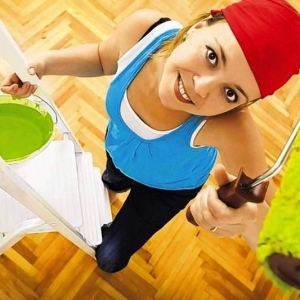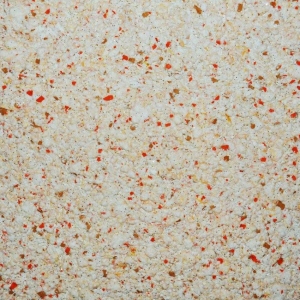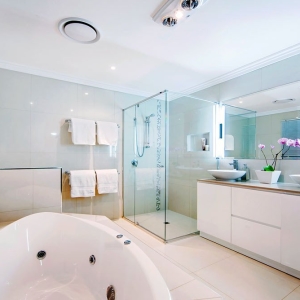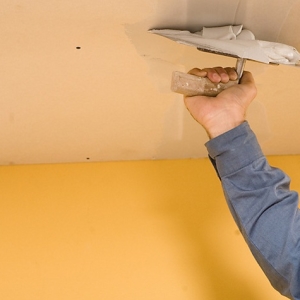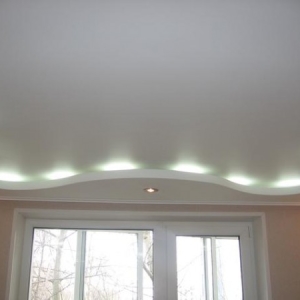There are many options for finishing the ceiling surface: pasting with wallpaper, installation of ceiling tiles, stretching canvas, core ceiling or multi-level design. But if the budget is limited, the owners resort to the painting of the ceiling of water-free paint.
The concept of water-emulsion
Poly-emulsion paint is a suspension, which contains polymers and pigment substances dissolved in water. After the composition is applied, water begins to evaporate intensively, and the polymers form a coating that is characterized by high resistance to moisture. The essential advantage of water-emulsion is that it is an environmentally friendly material.
Selection of waterfront paint
There are several varieties of water-level paints, depending on the polymer included in its composition, which we will talk more about:
- Acrylic. It is made on the basis of resin acrylic origin and is better for staining ceilings in any rooms, as it is characterized by high strength and elasticity, as well as resistance to the factors of the external environment. Thanks to the presence of latex behind the surface it is easy to care and washed. Acrylic composition is suitable even for painting an uneven base. Despite the fact that it is produced by a small color scheme, mainly light tones, if desired, the acrylic paint can be smoked and obtaining the desired shade.
- Silicone. As part of this paint, acrylic copolymers and silicone resin are present. As a result of its use, a vapor-permeable coating is formed, a resistant to the development of fungus, mold and moisture. Can be used for plastered ceiling surface without prior applying, in the kitchen and in the bathroom.
- Silicate. The water-produced water-based, which is made on a silicate basis, contains liquid glass and pigments. It is the most resistant to moisture compared to other types of water-emulsion paint. It is best suited for staining concrete, stone and plastered surfaces.
- Mineral. Such paints are made on the basis of lime and cement. They are unstable to external factors, and therefore are not short-lived, and have not found wide use.
Water-emulsion compositions are matte, semiam, glossy and semi-man. The glossy surface is characterized by higher qualities compared to matte: it is more resistant to wear, moisture resistant. But matte paint is able to mask small irregularities, small cracks and defects that are present on the ceiling. The most popular are semiam and semi-shy solutions.
When choosing a composition for staining the ceiling costs to carefully examine the label, namely, pay attention to the purpose of paint - staining the ceiling overlap, the degree of shellability, resistance to abrasion. If you characterize the last indicator, the inscriptions may be such: high resistance to dry abrasion; for dry premises with a reduced operational load; indelible; With dirt-repellent properties with intensive wash.

Preparation of the ceiling to paint
Of great importance is high-quality preparation of the ceiling surface to staining, which is as follows:
- If an old finish is present at the overlap, be it painting or whitewash, it needs to be removed. At first, the whols are blocked by a painting roller, which is abundantly witched in water, a chisel or spatula is used to remove residues. Then the surface is necessarily washed with a sponge.
- To remove old water-level paint, it will have to make more effort, because the substance in water is almost dissolved. Arm yourself with a spatula and remove the penetrated paint. To facilitate the work, you can moisten these sections twice, withstanding the interval in 20 minutes so that the old coating is well impregnated with water and swell. After open the windows and doors to create a draft. As a result, blooms are formed in the paint layer, which are easily approaching the spatula.
- After removal of the old coating, treat stains formed as a result of leaks and rust, 5% copper sulfate solution. A solution of hydrochloric acid (2-3%) is suitable for eliminating difficult to remove stains. Or you can prepare a solution from such ingredients: the crushing lime (20 parts), the olif (part 1), which should be imposed on the contamination of minutes by 10-15. As a rule, two similar procedures grabs to completely get rid of the problem.
- At the next stage, we are engaged in solving the ceiling using a thin layer putty. With it, it is necessary to close all the slots and cracks on the surface, if such formed after removing the old coating, previously reproving them for the convenience of work. Then the main surface is sweeping, and also pensing afterwards fine-grained emery paper. After carrying out the ceiling and drying it, you can move to painting.

Coloring ceiling surface
Go directly to the painting of the ceiling by water-mounted paint:
- Prepare such tools such as a fur roller for staining the main surface, a brush for processing joints, seams, angles, work correction, paint container.
- Start work from the very far corner in relation to the door, where the ceiling and wall are joined. Moisten the brush half in the paint, squeeze a bit and walk around the entire perimeter so that in the future do not spoil the corners.
- For staining the main ceiling surface with water-mounted paint, we use the roller. Make 3 layers. The first is recommended to make a parallel direction of the beams of light entering the room from the window. The following pass should be a parallel windows frame. Last refer to the window. Remember that each subsequent layer can only be carried out after the previous will dry well, approximately 8-12 hours later.
- Moisten the roller in the paint, then it should be done along the rough surface to evenly distribute the composition. When staining, a roller should move in the direction from left to right, and then to the other side, you can make W-shaped movements.
- In the process, visible transitions should not arise, focus on the quality, sending a bright light source on the ceiling. And during the last staining, it is better to use a new roller to obtain a homogeneous surface.

Defects coloring
Remember that it is impossible to dry the painted ceiling with electrical appliances, the drafts and direct hit of the rays of the sun are also invalid, which can provoke the appearance of spots on the decoration. If it was necessary to remove the excess and incidence of paint, after it is applied through the painted surface of the roller on which it is almost left almost left. If there are wide bands, you can talk about poorly mixed paint or that some kind of ceiling site was missed. The glare on the surface indicate the presence of irregularities on the basis and its poor-quality alignment, which can be corrected only by the shtocking of the surface.

For the staining of the ceiling by water-mounted paint, you can use the paintopult for the uniform distribution of the composition. This technique is best suited for a previously plastered surface and a brushed brushing or roller.













